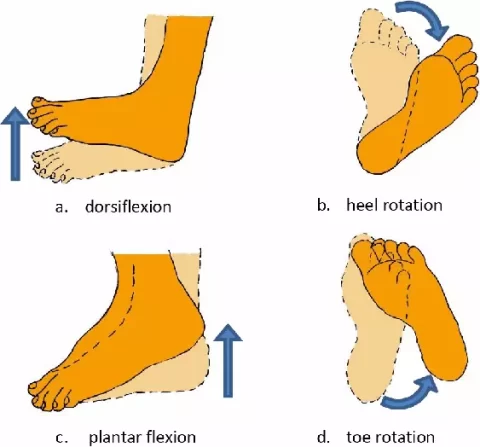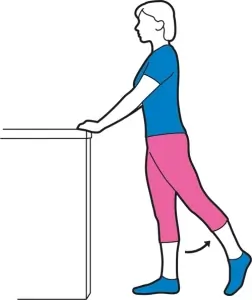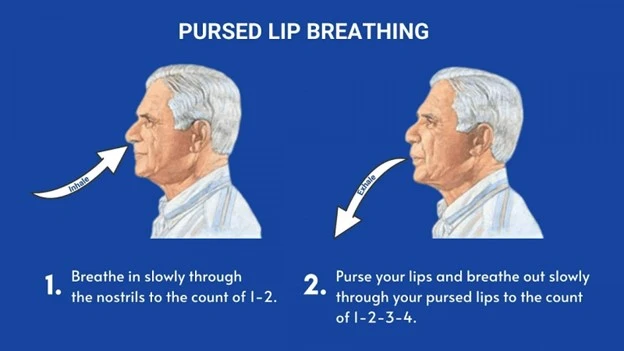Ankle Plantar Flexion
Ankle Plantar Flexion
Ankle plantar flexion is the movement of pointing the toes downward, away from the body, as in pressing a gas pedal. It engages muscles like the gastrocnemius, soleus, and plantaris, playing a key role in activities like walking, running, and jumping.
What are plantar and dorsi flexion of the ankle?
Two basic ankle joint movements—plantarflexion and dorsiflexion—are vital for various tasks, including walking, running, jumping, and maintaining balance. The foot is bent and extended at the ankle during these motions.
Pulling the top of the foot toward the shin, which brings the toes closer to the shinbone, is known as dorsiflexion. The muscles at the front of the lower leg, such as the tibialis anterior muscle, are primarily responsible for this motion. During the swing phase of walking, ankle dorsiflexion allows the foot to clear the ground, maintaining a fluid and effective gait pattern.
Plantarflexion is the movement of the toes away from the shinbone that causes the foot to descend downward. This action is mostly produced by the gastrocnemius and soleus muscles, which are located in the back of the lower leg. Plantarflexion is essential for activities like pushing off the ground when walking or running and maintaining balance when standing on tiptoe.
Ankle joint mobility, muscle strength and flexibility, past injuries, and specific medical disorders are some of the variables that may affect ankle dorsiflexion and plantarflexion. Regular stretching and strengthening exercises are important for maintaining a healthy range of motion and strength in both movements, which will maximize ankle function and lower the chance of injury.
Ankle plantar flexion: what is it?
Moving the foot downward and away from the shin is known as ankle-plantar flexion. The opposite motion of ankle dorsiflexion, which bends the foot upward toward the lower leg, is this one.
The ankle allows the foot to slide downward, directing the toes away from the torso, while it is in plantar flexion. The ankle joint, where the talus (foot bone) and tibia (shin bone) articulate, is where this movement mostly takes place. The calf muscles represent the main muscles on the back of the lower leg that are in control of plantar flexion of the ankle: 1. Gastrocnemius 2. The Soleus 3. The plantaris
When these muscles contract, the leg is directed downward and force is created for actions like pushing off the ground, running, walking, and jumping. In many functional actions, including walking on toes, standing on the balls of the feet, and moving the body forward, like when running or jumping, plantar flexion of the ankle is important. It additionally assists in maintaining equilibrium and stability.
A clinician, such as a physiotherapist or orthopedist, should be consulted if you have issues with ankle-plantar flexion to be able to provide a comprehensive evaluation and suitable treatment. They may provide specific guidance, exercises, and therapies for dealing with limits or dysfunctions related to ankle-plantar flexion.
Muscles of the Ankle Plantar Flexors
The dorsum of the foot contains the primary muscles that cause the ankle to plantar flex, or turn the foot downward. The following are the primary muscles used in plantar flexion of the ankle:
- Gastrocnemius: This is the calf’s bigger muscle, which is easily visible as a bulge on the back. Its two ends are the lateral end (outside side) and the medial end (inside side). The gastrocnemius is a powerful plantar flexor that runs through the ankle and knee joints. It is very active when you run, jump, or push off the ground.
- Soleus: Below the gastrocnemius muscle, deeper in the calf, lies a broad, flat muscle called the soleus. It additionally assists in plantar flexion of the ankle and crosses the ankle joint. Knee movements do not involve the soleus, in contrast to the gastrocnemius. When performing tasks like walking and squatting that call for knee bending, it is extremely active.
- The Plantaris: This muscle is slender and runs between the gastrocnemius and the soleus the lower leg. Although it is comparatively weaker and smaller than the gastrocnemius and plantarflexion, it helps in the plantar flexion of the ankle.
Together, these muscles create the force required to flex the ankle and foot and supply power for running, jumping, walking, and balancing on the balls of the feet. They also promote the pushing and shoving part of walking.
Ankle-plantar flexion can also be facilitated to a lesser degree by other muscles, such as the flexor hallucis longus and the tibialis posterior. However, the main ankle plantar flexors are the muscles listed above.
For the best ankle function and performance, it’s important to maintain the strength and flexibility of these muscles. It is advised that you consult a physician, such as a physiotherapist or sports medicine expert, for assessment and suitable therapy if you have issues with ankle-plantar flexion.
Ankle plantar flexion range of motion
Different people can occur in the degree of ankle-plantar flexion, or the foot’s downward movement. However, it is generally accepted that the ankle joint’s typical range of motion for plantar flexion is between 40 and 50 degrees.
The toes turn downward when the foot descends and separates from the shin during ankle plantar flexion. This movement mostly takes place at the ankle joint, which is where the talus (foot bone) and tibia (shin bone) articulate.
Ankle flexion range of motion can be measured with a goniometer, a device used to measure joint angles. To determine the angle created between the foot and forefoot during plantar flexion, a goniometer is typically positioned with the foot and forefoot.
The plantar flexion of the ankle can vary from person to person depending on several factors, including muscle flexibility, joint structure, genetics, and previous injuries. Many factors, such as tight muscles, stiff joints, or constraints in soft tissues, can result in limited ankle plantar flexion.
A physician, such as a physiotherapist or orthopedist, should be consulted if you have pain or difficulties moving or if you have concerns regarding the ankle’s plantar flexor region. To improve ankle plantar flexion, they can evaluate your particular condition, advise proper interventions, and, if required, guide you through exercises or therapies.
Ankle-plantar flexion range of motion can be measured as follows.
- Positioning: Ask that person to sit with their legs out in front of them on a sturdy platform.
- Stabilization: Make sure the heel does not come out by keeping the foot on the ground or another stable surface.
- Alignment: Observe that neither the leg nor the foot are rotated in or out.
- Zero point: Find the foot’s starting position without plantar flexion, also known as the zero point.
- Measurement: To determine the plantar flexion angle, use a goniometer, a rotating arm device, and steps.
- Place the goniometer so that its center of rotation lines up with the center of rotation of the ankle joint.
- Placement of the Stationary Arm: Place the goniometer’s fixed arm toward the hip joint by aligning it with the leg.
- Placement of the moving arm: Put the goniometer’s moving arm toward the toes and line it up with the leg.
- Range of Motion: Holding the goniometer in place, ask the subject to slowly point their foot downward (plantar flexion). Maintain the leg’s position throughout the movement.
- Examine the measurement: Read the goniometer’s degree reading once the subject achieved maximum plantar flexion. The ankle-plantar flexion range of motion is given by this measurement.
- Again: For maximum clarity and regularity, take the measurement two or three times.
- Take note of the measurements: Range of motion measurements are to be kept on file for future reference or comparison.
To ensure the person’s comfort and cooperation, always be kind and talk to them during the procedure.
Ankle Plantar Flexion Special Test
The “heel raise” or “calf raise” is a popular test for evaluating ankle plantar flexion. Typically, this is carried out as follows.
- Place yourself close to a wall or other sturdy object that you may lean on for support if necessary.
- Position your toes forward and place your feet shoulder-width apart.
- Lift your heels off the floor and press your feet through the balls as you slowly stand up to your toes.
- For a complete range of motion, raise your heels as high as you can.
- After a few seconds of holding the elevated position, gradually return your heels to the beginning position.
- Do the motion multiple times.
- This test allows you to evaluate the ankle joint’s plantar flexion strength and range of motion.
Test for Ankle Plantar Flexion
The “Thompson Test” or “Ankle Plantar Flexion Test” is a specialized examination used to evaluate the ankle joint’s plantar flexion.
- The Achilles tendon’s integrity is evaluated using the Thompson test, which is crucial for ankle plantar flexion.
- This procedure is normally carried out to rule out an Achilles tendon rupture. The typical method for administering the Thompson test is:
- The person generally rests on an examination table or bed with their legs hanging over the edge, supine (bottom in the photo).
- When examining both feet, the examiner looks for any obvious variations in alignment or appearance.
- The examiner uses his hands to squeeze the affected leg’s calf muscle or applies pressure to the calf when the subject’s legs are relaxed and hanging.
The examiner observes how the foot and ankle move—or don’t move—during this stretch. Squeezing the calf muscle normally results in the sole flexing, or going down. On the other hand, the injured leg will move very little or simply at all if the Achilles tendon ruptures. A positive Thompson test results from the lack of movement.
It is important to remember that the Thompson test is only used to evaluate the Achilles tendon; it is not a general evaluation of the range of motion in ankle-foot flexion. A medical practitioner, such as a physiotherapist or orthopedist, may perform a more thorough examination using a goniometer or other specialist testing if you require a full ankle range of motion, including plantar flexion. For an accurate diagnosis and suitable treatment, Experts advise consulting a medical expert if you have concerns regarding ankle-plantar flexion or suspect Achilles tendon damage.
Ankle Plantar Flexion Exercise
Specifically, ankle plantar flexion is a movement in which the foot moves downward and away from the lower leg. You can add the following exercises into your program to strengthen and improve ankle plantar flexion:
Calf Raises:
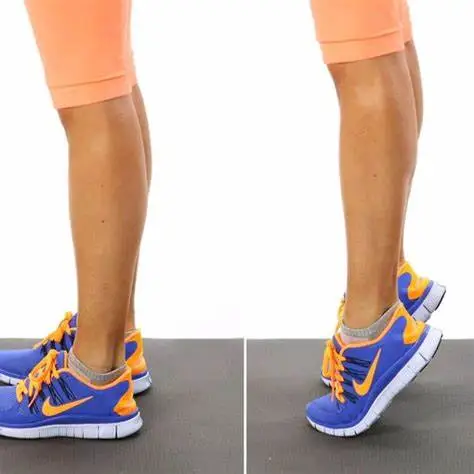
Keep your feet hip-width apart and, if necessary, rest your hands on a sturdy surface. Elevate your heels to the maximum height while standing on your toes. After a second of holding the pose, carefully drop your heels. Perform 10–15 repetitions.
Seated leg raises:
Sit on a chair or bench with your knees bent at a 90-degree angle and your feet flat on the floor. A dumbbell or other weight should be placed on your thighs close to your knees. In order to elevate your heels as high off the ground as possible, press your feet against the balls of your feet. Take a brief pause at the top before lowering your heels. Perform 10–15 repetitions.
Resistance Band Plantar Flexion:
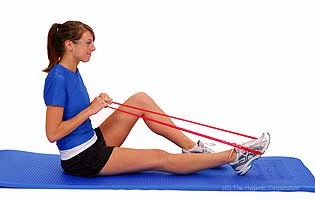
Sitting on the floor, extend your legs in front of you and engage in plantar flexion. Holding the strap’s ends in your hands, wrap the resistance band around the balls of your feet. Point your toes as far away from your body as you can after bending your legs to put tension on the strap. Return to the starting position gradually. Perform multiple sets of ten to fifteen repetitions.
Toe walking:

Maintaining the toe stance, taking little steps forward while standing tall, and raising yourself on the balls of your feet. When tiptoeing for a certain period or distance, concentrate on keeping your balance and control.
Stair Calf Raises:

Place the balls of your feet on the step with your heels hanging down as you stand on the edge of a stairway or step. For support, hold to a wall or railing if required. Lower your heels below the step’s level, then push your heels as high as you can by pressing your feet into their balls. Do ten to fifteen repetitions.
These exercises must be done properly, beginning with a range of motion that is comfortable and progressively increasing the resistance and intensity as tolerated. It is advised that you seek advice from a medical professional, such as a physiotherapist, for advice and individualized workout recommendations if you have diseases or issues. They can determine your specific requirements and offer suitable exercises to safely and successfully increase ankle-foot flexion.
Manual Muscle Testing For Ankle plantar flexion
A physical examination technique called ankle manual muscle testing, or MMT, is used to assess the strength and functionality of the muscles that surround the ankle joint. It is commonly used by medical professionals, such as physicians and physical therapists, to evaluate muscle weakness, track the effectiveness of rehabilitation, or pinpoint particular ankle problems.
Muscle testing
- Gastrocnemius
- Soleus
Position of the patient
To examine the soleus and gastrocnemius together:
The patient can use stable objects, such as a table or bench, to balance oneself while standing on the examined leg and knee extension to evaluate grades 3-5.
The patient should be side-lying, knee extended, and ankle off the bed in order to assess grades 0–2.
Position of the Therapist
In order to evaluate grades 3-5 The therapist needs to be suitably positioned so that they can observe the movements from the side.
Standing at the feet of the subjects, the therapist assesses them in grades 0–2.
What is the test procedure?
- Explain the process to the patient: Before beginning the test, ask the patient to cooperate and explain the process. When they push down, let them know that you will be increasing the resistance against their foot.
To evaluate plantar flexion, the patient will perform a single-limb heel rise. - Joint stabilization: Put one hand on each side of the ankle to support the joint being examined. Any uncomfortable movement during the test will be avoided as a result.
- Provide resistance: As the patient pulls down, provide their foot ball resistance. Don’t apply too much force to overwhelm the patient’s effort, but enough to give resistance.
- Observe for range of motion: As the patient presses down, check for the entire range of motion. Make a note of any incomplete range of motion.
- Assess muscular strength: Assess muscle strength based on the patient’s effort and the level of resistance used. Utilize the 0–5 grading method.
- Grade 0: There is no noticeable contraction
- Grade 1: Only a fleeting sensation or indication of contraction is there, no movement.
- Grade 2: Perform the movement horizontally or without the use of gravity.
- Grade 3: Move against gravity without resistance.
- Grade 4: Use mild to moderate resistance force while moving against gravity.
- Grade 5: perform the movement that goes against your strongest muscles.
- Repeat the test on both sides to compare the muscle strength and find any differences.
- Record: Enter the muscle strength score and any test-related observations in the patient’s medical file.
- Interpretation: A qualified healthcare professional should evaluate the data, accounting for other factors like age, gender, medical history, and other clinical findings.
FAQs
How can the plantar flexion of the ankle be strengthened?
Straighten your right leg and sit on a bed or the floor.
Wrap your right foot with an elastic exercise band or tubing.
Using the ball of your foot and pointing your toes, press down on the elastic band.
As directed, repeat ten times.
Follow the directions or perform this exercise three times a day.
What is an ankle plantar flexion example?
When walking, the foot is bent downward to propel the body off the ground and forward. Reaching for something on a high level while standing on tiptoes. Pressing down on an automobile’s gas pedal. Jumping as the feet point downward to raise the body off the ground.
What is plantar flexion weakness?
Because weak plantar flexors are unable to lift the body weight, there is a noticeable impairment in gait and significant energy consumption. The ankle joint cannot be stabilized during the stance phases. There’s a knee hyperextension.
What are the benefits of ankle plantar flexion?
When you walk, step up on your tiptoes, or push the pedals on a piano or car, you are using plantar flexion. It can also be used for exercises and other daily actions, such as jumping.
Which three muscles are involved in plantar flexion?
The gastrocnemius, soleus, and plantaris are the superficial muscles that make up the foot’s primary plantar flexors. Their tendons converge to form the tendon calcaneus, also known as the Achilles tendon. The posterior surface of the calcaneus is where the tendon Achilles is connected.
How do you stretch for plantar exercises?
While seated on a chair, place the injured heel over the other leg. Pull the toes toward the shin to tighten the foot’s arch. Feel for plantar fascia tension with the other hand on the sole of the foot. Hold for ten seconds, then repeat two or three times.
References:
- Patel, D. (2023e, July 13). Ankle dorsi flexion and planter flexion. Samarpan Physiotherapy Clinic. https://samarpanphysioclinic.com/ankle-dorsi-flexion-and-planter-flexion/
- Patel, D. (2023c, May 29). Manual Muscle Testing of Ankle(MMT of Ankle Muscle) – Samarpan. Samarpan Physiotherapy Clinic. https://samarpanphysioclinic.com/manual-muscle-testing-of-ankle/#Ankle_plantar_flexion

